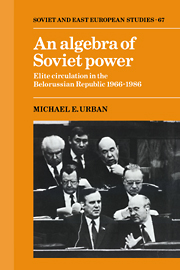Book contents
- Frontmatter
- Contents
- List of figures and tables
- Preface
- Acknowledgements
- 1 Method, model and historical background
- 2 Hierarchy, mobility and a stratified model
- 3 Centralization as a determinant of elite circulation
- 4 The regional structure of elite circulation
- 5 The structure of patronage affiliations
- 6 Does faction make a difference?
- 7 Political succession
- 8 Conclusions, implications and the question of levels
- Appendix A Stratification of positions in the Belorussian Republic, 1966–86
- Appendix B A roster of factional groups in the Belorussian Republic, 1966–86
- Notes
- Index
- Soviet and East European Studies
8 - Conclusions, implications and the question of levels
Published online by Cambridge University Press: 09 November 2009
- Frontmatter
- Contents
- List of figures and tables
- Preface
- Acknowledgements
- 1 Method, model and historical background
- 2 Hierarchy, mobility and a stratified model
- 3 Centralization as a determinant of elite circulation
- 4 The regional structure of elite circulation
- 5 The structure of patronage affiliations
- 6 Does faction make a difference?
- 7 Political succession
- 8 Conclusions, implications and the question of levels
- Appendix A Stratification of positions in the Belorussian Republic, 1966–86
- Appendix B A roster of factional groups in the Belorussian Republic, 1966–86
- Notes
- Index
- Soviet and East European Studies
Summary
Elite circulation in the Soviet system is, as we have seen, a complex process. A number of studies that have sought to disentangle the many factors involved, to single out some collection of causes and to relate these to specific effects by way of a comprehensive set of propositions which explain the process have not met with great success. There is no reason to suppose that the analysis conducted here, although its methodological orientation sets it apart from other works in the field, is an exception in this respect. It may be that the indeterminacy of the results found in a great many studies of Soviet elites that have searched for correlations between a set of independent variables (the attributes of officials, the economic performance of the units that they superintend, and so forth) and the dependent variable of elite mobility is traceable to the question of levels of analysis. Individual-level data, for instance, may show some correlation with systems-level phenomena such as policy or systems change, as the model depicted in Figure 1.1 would have it. Yet the interpretation of such, not to mention the weakness of the correlations commonly reported in the literature, generally leaves much to be desired from the standpoint of conceptual adequacy. It is not at all clear, for example, that the Soviet Union is becoming more or less ‘modern’ or ‘developed’ because its political elite is becoming older or younger, more or less educated, or practiced in one or many occupational categories.
- Type
- Chapter
- Information
- An Algebra of Soviet PowerElite Circulation in the Belorussian Republic 1966–86, pp. 136 - 141Publisher: Cambridge University PressPrint publication year: 1989



